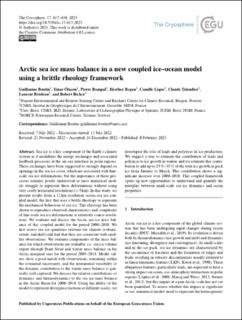| dc.contributor.author | Boutin, Guillaume | |
| dc.contributor.author | Olason, Einar | |
| dc.contributor.author | Rampal, Pierre | |
| dc.contributor.author | Regan, Heather | |
| dc.contributor.author | Lique, Camille | |
| dc.contributor.author | Talandier, Claude | |
| dc.contributor.author | Brodeau, Laurent | |
| dc.contributor.author | Ricker, Robert | |
| dc.date.accessioned | 2023-11-24T12:12:44Z | |
| dc.date.available | 2023-11-24T12:12:44Z | |
| dc.date.created | 2023-02-08T14:46:44Z | |
| dc.date.issued | 2023 | |
| dc.identifier.citation | The Cryosphere. 2023, 17 (2), 617-638. | en_US |
| dc.identifier.issn | 1994-0416 | |
| dc.identifier.uri | https://hdl.handle.net/11250/3104546 | |
| dc.description.abstract | Sea ice is a key component of the Earth's climate system as it modulates the energy exchanges and associated feedback processes at the air–sea interface in polar regions. These exchanges have been suggested to strongly depend on openings in the sea ice cover, which are associated with fine-scale sea ice deformations, but the importance of these processes remains poorly understood as most numerical models struggle to represent these deformations without using very costly horizontal resolutions (≃ 5 km). In this study, we present results from a 12 km resolution ocean–sea ice coupled model, the first that uses a brittle rheology to represent the mechanical behaviour of sea ice. This rheology has been shown to reproduce observed characteristics and complexity of fine-scale sea ice deformations at relatively coarse resolutions. We evaluate and discuss the Arctic sea ice mass balance of this coupled model for the period 2000–2018. We first assess sea ice quantities relevant for climate (volume, extent, and drift) and find that they are consistent with satellite observations. We evaluate components of the mass balance for which observations are available, i.e. sea ice volume export through Fram Strait and winter mass balance in the Arctic marginal seas for the period 2003–2018. Model values show a good match with observations, remaining within the estimated uncertainty, and the interannual variability of the dynamic contribution to the winter mass balance is generally well captured. We discuss the relative contributions of dynamics and thermodynamics to the sea ice mass balance in the Arctic Basin for 2000–2018. Using the ability of the model to represent divergence motions at different scales, we investigate the role of leads and polynyas in ice production. We suggest a way to estimate the contribution of leads and polynyas to ice growth in winter, and we estimate this contribution to add up to 25 %–35 % of the total ice growth in pack ice from January to March. This contribution shows a significant increase over 2000–2018. This coupled framework opens up new opportunities to understand and quantify the interplay between small-scale sea ice dynamics and ocean properties. | en_US |
| dc.language.iso | eng | en_US |
| dc.rights | Navngivelse 4.0 Internasjonal | * |
| dc.rights.uri | http://creativecommons.org/licenses/by/4.0/deed.no | * |
| dc.title | Arctic sea ice mass balance in a new coupled ice–ocean model using a brittle rheology framework | en_US |
| dc.title.alternative | Arctic sea ice mass balance in a new coupled ice–ocean model using a brittle rheology framework | en_US |
| dc.type | Peer reviewed | en_US |
| dc.type | Journal article | en_US |
| dc.rights.holder | © Author(s) 2023 | en_US |
| dc.description.version | publishedVersion | en_US |
| cristin.ispublished | true | |
| cristin.fulltext | original | |
| cristin.qualitycode | 2 | |
| dc.identifier.doi | 10.5194/tc-17-617-2023 | |
| dc.identifier.cristin | 2124207 | |
| dc.source.journal | The Cryosphere | en_US |
| dc.source.volume | 17 | en_US |
| dc.source.issue | 2 | en_US |
| dc.source.pagenumber | 617-638 | en_US |

